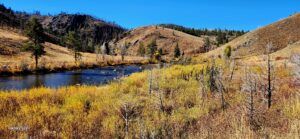
As the leaves change colors and the air turns crisp, fall fishing in 6 Mile Canyon offers a unique opportunity to hone your skills and target brown trout like never before. Let’s delve into effective tenkara fishing techniques, essential American Tenkara tips, and fall fly fishing strategies designed to help you land those elusive brown trout in this picturesque location. We’ll also cover fly patterns and how to maximize your 6 Mile Canyon adventure. So grab your waders, gather up your gear, and read on to learn the secrets of fall fly fishing success in one of America’s most captivating canyons!
Choosing the Right Tenkara Gear for Fall Fishing
When it comes to fall tenkara fishing in 6 Mile Canyon, consider the specific needs of this season and location. What size fish will I be getting into? Water type of water is it? On average, what cast distance will be required, and how easy is the river to wade? 6 Mile Canyon requires a tenkara rod that can handle various water conditions and fish sizes. A 12-15 foot rod with a medium to fast action is an excellent choice since it will provide reach, sensitivity to detect subtle strikes from brown trout, yet must be powerful enough to control fish in water that often resembles an obstical course due to the many boulders, falls and narrow, deep, rocky channels found in this stretch of river.
Lines and tippets are a vital components of your tenkara setup that will directly impact casting accuracy and control over presentations. In autumn’s lower water levels, choose a longer, floating line paired with a slightly longer appropriate tippet material (usually between 4x-5x) based on desired presentation style. This combination offers better stealth capabilities when targeting wary brown trout during their pre-spawn period who spook at the slightest sound or disturbance. While a short setup seems like a good choice in some of these conditions, it is not always easy to reach pools and seams on this fairy wide river and stealth, meaning distance, is helpful when targeting brown trout.
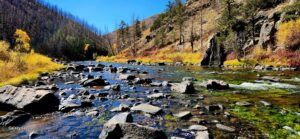
6 Mile Canyon requires technical fishing. The water is clear, the fish are leary, and the river has lots of eddies, backflows and complicated seams to cover. Brown trout are smart. They are more territorial than rainbows and don’t school up together as much as rainbows do. Often there is only a single fish in a run and you genrally will have one maybe two shots, to hook it. Your fly box should be filled with seasonal fly patterns designed to imitate insects or baitfish during the fall months. This isn’t the kind of water for non descript Sakasa Kebari fly patterns. Think along the lines of streamers like Woolly Buggers which mimic larger prey such as leeches or crayfish, nymphs like Hare’s Ear imitating aquatic larvae drifting downstream due to changing weather conditions, or egg-sucking leech patterns. Stonefly patterns representing opportunistic feeding behavior amongst these predatory fish also work great paired with tiny nymphs or midges.
Tenkara Techniques to Target Brown Trout in 6 Mile Canyon
Tenkara techniques for targeting brown trout in 6 Mile Canyon require a thorough understanding of the water conditions, fish behavior, and how to adapt your approach accordingly. As fall sets in, brown trout become more aggressive and territorial due to their pre-spawn phase. This is an ideal time to employ tenkara tactics that capitalize on this increased activity.
Brown trout are known for their wariness, so it’s crucial to maintain a low profile and avoid casting shadows on the water surface. Approach each pool or run from downstream whenever possible, allowing your flies to drift naturally into the feeding lanes without spooking the fish. This means to keep your shadow out of sight crossing the river multiple times throughout the day will need to occur with the twists and turns of the canyon and the changing light. Walk as quietly as possible. Remember, brown trout don’t return quickly to their feed lane after being spooked.
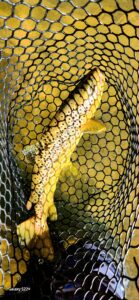
Another essential tenkara technique involves adapting your casting style based on your surroundings. This stretch of water is fairly wide with plenty of room to backcast or cast overhead. During fall when water levels are low, disceting the river becomes easier since wading also becomes easier. It’s important to not just focus on traditional riffles but to also explore pockets behind rocks or undercut banks where the browns often lie hidden.
Be strategic about timing during your 6 Mile Canyon adventure. This stretch of the North Platter River can be popular with fly anglers. With an elevation of about 6000ft, early morning fall temperatures are get pretty low and keep brown trout sluggish and hunkered down until the water warms slighty. As the day progresses and tempuratures rise, these fish wake up with an appetite, start aggressively feeding and the additional warmth means hatches are more likely to occur.
Seasonal Fly Patterns for Effective Brown Trout Tenkara
Seasonal fly patterns play a crucial role in the success of your brown trout tenkara fishing experience. As fall temperatures change and aquatic insects become less abundant, it’s essential to adapt your flies to mimic the food sources available during this time. By carefully selecting seasonal fly patterns for 6 Mile Canyon, you’ll significantly enhance your chances of hooking these picky brown trout.
Begin by focusing on three primary types of flies: nymphs, streamers, and dry flies. Nymphs imitate immature stages of aquatic insects and are ideal for enticing brown trout lurking below the surface in search of an easy meal. In fall months, opt for smaller nymphs with darker tones to resemble commonly found insect larvae such as stoneflies or mayflies at this time. Make sure your tippet length is long enough and you are getting down deep enough to actually reach the fish that often hold at the bottom of pools.
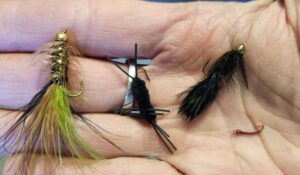
Many fly anglers make the mistake of choosing effective and productive fly patterns but don’t set them up at an effective depth. They think the patterns aren’t working when in fact the fish simply don’t see them or won’t move that far to strike them. Make sure your your flies are getting down deep enough and reaching those brown trout.
Streamers are another effective option when targeting brown trout in 6 Mile Canyon. These larger wet flies emulate baitfish or small prey that might entice opportunistic feeders like browns during autumn months when their natural prey is scarcer than usual. Choose streamer colors that mimic local baitfish colors – olive green and black are successful choices.
Dry flies are not as commonly used during fall fishing but should not be overlooked; they simulate adult stages of various insects resting on the water’s surface and can trigger strikes from hungry browns eager to snatch them up before they escape upstream into colder waters where feeding opportunities will become increasingly limited as winter season approaches. When selecting dry flies for Tenkara fishing in 6 Mile Canyon, consider beige grasshoppers or big chubbies that can suspend a dropper nymph while riding the waves and curruents of seams. This two-fly method, while not practiced in “traditional tenkara”, is extrememly efficient in American Tenkara and allows anglers to work both above and below the water surface to increase prospecting opportunities. Even when most strikes are occuring beneath the surface on nymphs, you might be surprised when a massive brown unexpectedly rises, catching you completely off guard, to slam your juicy dry fly in a last indulgence before these insect treats disappear for winter.
A Few Final American Tenkara Tips for 6 Mile Canyon
As a tenkara angler in pursuit of brown trout, it’s essential to familiarize yourself with the canyon’s features and challenges while honing your skills. Knowing where to find brown trout within 6 Mile Canyon is first and foremost. Scouting areas near overhanging trees or submerged structures can significantly increase your chances as these provide ideal cover for fish seeking refuge during fall months and staying out of the view of birds such as eagles and osprey. Also, pay attention to water temperature changes throughout the day; early morning and late afternoon often yield more success in summer months. But as fall sets in and night temperatures drop, water may need time to warm up and make brown trout more active and prone to feeding.
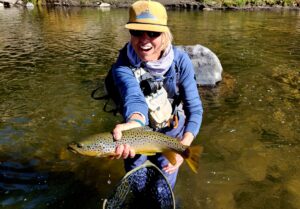
Remember, 6 Mile Canyon is requires technical fishing. Stealthy approaches, minimal noise or sudden movements, and being aware of your shadow will make a positive impact on your fishing productivity. Using fly patterns that are non-traditional tenkara patterns and are seasonal and insect-specific, such as caddisflies or stoneflies, will be a vital component when enticing selective feeders like brown trout on technical water. Adaptability is also key when targeting these fish – don’t hesitate switching up fly patterns if what you’re currently using isn’t working. Browns are notoriously finicky. Experimenting with different fly patterns like egg-sucking leeches during spawning times or local terrestrials like beetles & grasshoppers, could very well give you the edge needed to lure them into an agressive strike.
Zen Tenkara Rod: Which Rod and Why
The last thing you want is to hook into one of these incredible brown trout only to have your tenkara rod break or to loose it due to lack of control. in strong currents or around boulders and rocks. By choosing the right gear you’ll be well on your way to ensuring success. The Zen Tenkara Sagi is an excellent choice for this type of water and this type of fishing. The Zen Sagi is 13ft 6in to cover this wide river and reach over back eddies. The Sagi is also very sensitive to help you feel delicate takes on tiny nymphs, yet it has the power to steer and control big brown trout and avoid break or rub offs. As you embrass fall fishing and possibly a 6 Mile Canyon adventure, or another spectacular fall fishing destination, elevate your tenkara fishing game, —invest in a Zen Tenkara rod today and experience the difference for yourself.




Great article Karin.I love my Sagi it’s my go to rod for difficult water